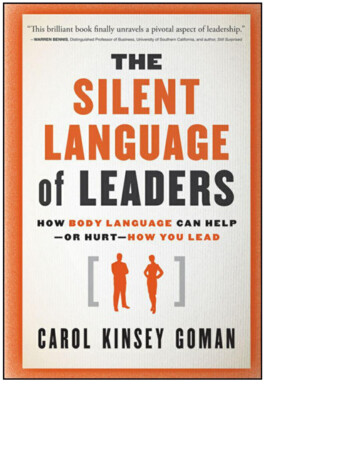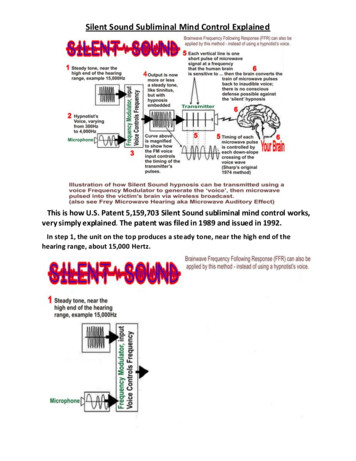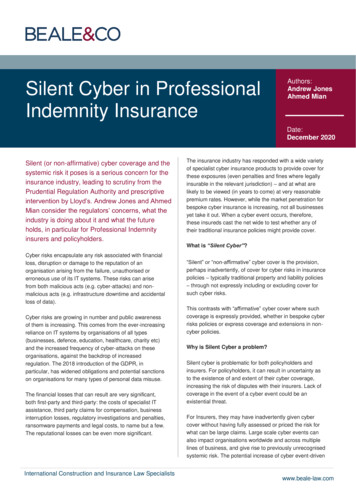
Transcription
Table Of ContentsTitle PageCopyrightMore praise for The Silent Language of Leaders
IntroductionOh, the Things I've Seen!The Time Is Right
Chapter OutlineFrom Good to Outstanding
Chapter 1: Leadership at a GlanceYour Three BrainsWired for Body LanguageThe Eye of the BeholderPersonal Curb AppealFive Mistakes People Make Reading Your Body LanguageWhen Your Body Doesn't Match Your WordsThe Body Language of a Great Leader
Chapter Two: NegotiationFour Tips for Reading Body LanguageAre They with You or Against You?Dealing with the DisengagedAre They Bluffing?Body Language Guidelines for Negotiators
Chapter 3: Leading ChangeThis Is Your Brain on ChangeThe Body-Mind ConnectionAnnouncing ChangeWhat Do People Want from You?The Power of Empathy
Chapter 4: CollaborationThe Universal Need for CollaborationWired to ConnectSix Body Language Tips for InclusionThe Importance of How You Say What You SayUsing SpaceDress for SuccessWhat Your Office Says About YouFamiliarity Breeds Collaboration
Chapter 5: Communicating Virtually and Face-to-FaceTechnology, the Great EnablerSix Tips for a Conference CallImportant Tips for VideoconferencingTechnology Brings a New Range of Communication OptionsWhat's So Great About Face-to-Face?Chapter 6: He Leads, She LeadsThe Neuroscience of GenderWhy Jane Doesn't LeadThirteen Gender-Based Differences in Nonverbal CommunicationLeadership Styles of Men and WomenThe Body Language of Male and Female LeadersBody Language Tips for Male and Female LeadersMen Are from Mars, Women Are from Venus
Chapter 7: Working with Global TeamsCultureCross-Cultural Body LanguageLessons Learned
Chapter 8: International Body LanguageGreeting BehaviorsBusiness CardsTimeDistance and TouchEye ContactSeatingEmotionsWomenClosing Words of AdviceChapter 9: The Nonverbal Future of LeadershipAll Generations Bring ChangeThe New Generation of WorkersGen Y and the Future of Visual TechnologyThe Future of LeadershipPredictions for the Future of Body LanguageAcknowledgmentsAbout the AuthorNotes
IntroductionChapter One: Leadership at a Glance: How People Read the Body Language of LeadersChapter Two: Negotiation: Reading and Using Body Language to Your AdvantageChapter Three: Leading Change: The Nonverbal Key to Effective Change ManagementChapter Four: Collaboration: Body Language Cues for InclusionChapter Five: Communicating Virtually and Face-to-Face: Close Encounters of the Business KindChapter Six: He Leads, She Leads: Gender and the Body Language of LeadersChapter Seven: Working with Global Teams: Body Language in a Multicultural WorldChapter Nine: The Nonverbal Future of Leadership: New Generations and New TechnologyIndex
Copyright 2011 by Carol Kinsey Goman. Al rights reserved.Published by Jossey-BassA Wiley Imprint
989 Market Street, San Francisco, CA 94103-1741—www.josseybass.comNo part of this publication may be reproduced, stored in a retrieval system, or transmitted in any formor by any means, electronic, mechanical, photocopying, recording, scanning, or otherwise, except aspermitted under Section 107 or 108 of the 1976 United States Copyright Act, without either the priorwritten permission of the publisher, or authorization through payment of the appropriate per-copy feeto the Copyright Clearance Center, Inc., 222 Rosewood Drive, Danvers, MA 01923, 978-750-8400, fax978-646-8600, or on the Web at www.copyright.com. Requests to the publisher for permission shouldbe addressed to the Permissions Department, John Wiley & Sons, Inc., 111 River Street, Hoboken, NJ07030, 201-748-6011, fax 201-748-6008, or online at www.wiley.com/go/permissions.Readers should be aware that Internet Web sites offered as citations and/or sources for furtherinformation may have changed or disappeared between the time this was written and when it is read.Limit of Liability/Disclaimer of Warranty: While the publisher and author have used their best effortsin preparing this book, they make no representations or warranties with respect to the accuracy orcompleteness of the contents of this book and specifical y disclaim any implied warranties ofmerchantability or fitness for a particular purpose. No warranty may be created or extended by salesrepresentatives or written sales materials. The advice and strategies contained herein may not besuitable for your situation. You should consult with a professional where appropriate. Neither thepublisher nor author shal be liable for any loss of profit or any other commercial damages, includingbut not limited to special, incidental, consequential, or other damages.Jossey-Bass books and products are available through most bookstores. To contact Jossey-Bassdirectly cal our Customer Care Department within the U.S. at 800-956-7739, outside the U.S. at 317572-3986, or fax 317-572-4002.Jossey-Bass also publishes its books in a variety of electronic formats. Some content that appears inprint may not be available in electronic books.Library of Congress Cataloging-in-Publication DataGoman, Carol Kinsey.The silent language of leaders : how body language can help—or hurt—howyou lead / Carol Kinsey Goman. – 1st ed.p. cm.Includes bibliographical references and index.ISBN 978-0-470-87636-7 (hardback)1. Body language. 2. Nonverbal communication in the workplace.3. Communication in management.4. Leadership. 5. Communication in organizations.I. Title.
BF637.N66G664 2011650.1′3–dc222010050248More praise for The Silent Language of Leaders“Learn to align your verbal and non-verbal communication and you are on your way to becoming abetter leader. The Silent Language of Leaders is the only book you need to bring yourself up to speed.”—Karen Tucker, CEO, Churchill Club“Successful business executives understand and achieve higher levels of effectiveness when theirwords are in sync with their body language.Carol Kinsey Goman's new book showcases the important body language techniques needed to buildtrust in a rapidly changing world. Savvy executives wil use her recommendations immediately tobuild stronger relationships, shape perceptions, and get results.”—Lee Hornick, program director, The Conference Board, and president, Business CommunicationsWorldwide, Inc.“This book is an outstanding resource to help managers at al levels become better communicators andleaders.”—Shirley Gaufin, chief human resources officer, Black & Veatch Corporation“Whether it's in front of an individual or a large group, communication is a key component of yourleadership success. And a major aspect of that success is your body language. This silent method ofcommunication can be deadly if you don't know the signals that you are sending.Carol Kinsey Goman provides a guidebook to help you navigate this complex aspect of leadership.”—Jon Peters, president, The Institute for Management Studies“People don't realize how their true strengths and weaknesses are revealed by their body language.Carol Kinsey Goman's observations and insights are unique.”—Charles Lynch, chairman, Market Value Partners
IntroductionThe Leadership–Body Language ConnectionLeadership is about communication. You already know that. So, in preparing for an importantmeeting, you concentrate on what to say, you memorize crucial points, and you rehearse yourpresentation so that you wil come across as credible and convincing.But did you also know that the people you're speaking to wil have subliminal y evaluated yourcredibility, confidence, likeability, and trustworthiness in the first seven seconds—before you had achance to deliver your wel -rehearsed speaking points? Did you know that your use of personal space,physical gestures, posture, facial expressions, and eye contact could already have sabotaged yourmessage? And, most critical y, did you know that any time your words and body language were out ofalignment, people believed what they saw and not what you said?So, if you went into that important meeting with al the right words and al the wrong moves, youprobably left sensing that things didn't go as wel as you'd hoped. But you might not know why.Leadership is also about building and sustaining positive relationships. You know that too. You travelto meet personal y with key customers, go out with coworkers to get to know them better, arrange“town hal ” meetings in order to interact more closely with frontline workers.But did you know that your ability to accurately read and respond to the body language of others isfundamental to building empathy and rapport?If you misinterpreted and ignored important nonverbal signals from your col eagues, customers, oremployees, you probably parted company feeling vaguely dissatisfied with the relationship you'destablished, again not knowing why, but realizing something needed to be done about it.That's when you might hire me.I get paid to stalk leaders.Wel , not literal y, but that is how one of my satisfied clients humorously described my services.I'm a professional communicator, the author of eleven business books, and an international keynotespeaker. But when I'm not traveling around the world on speaking engagements, I coach people likeyou—managers, team leaders, entrepreneurs, and senior executives who are looking for ways tobecome even more effective in their ability to relate with and influence others.So, I stalk—more accurately, “shadow”—these leaders, observing them as they run meetings, interactinformal y with employees and col eagues, consult with customers, negotiate business deals, and makeformal presentations.Oh, the Things I've Seen!Body language is the management of time, space, appearance, posture, gesture, vocal prosody, touch,smel , facial expression, and eye contact.
The latest research in neuroscience and psychology has proven that body language is crucial toleadership effectiveness—and this book wil show you exactly how it impacts a leader's ability tonegotiate, manage change, build trust, project charisma, and promote col aboration. But my interest inbody language started long before I gave speeches or coached leaders. In training for my previousoccupation as a therapist in private practice, I learned to pay close attention to nonverbal signals. Indoing so, I became aware of the way body language can underscore what a person is saying, but canalso undermine or even contradict it. When very relaxed, people had certain ways of entering myoffice and certain physical positions that they assumed. But when they were concerned orunconvinced, their postures and expressions changed dramatical y. I also saw that quite often theirbody language was in direct opposition to their words, and I learned to trust the subliminal messagesfrom their bodies as much as, or more than, their verbal responses. Soon it became second nature to“decode” body language cues and to use what I discovered to help people overcome internal resistanceand to reinforce personal motivation in order to make positive changes in their lives.When I started to coach organizational leaders, I was surprised to find how unfamiliar businesspeoplewere with nonverbal communication. For the past twenty years, I've studied and been awed by theimpact of body language on leadership results. I've seen firsthand how nonverbal signals can literal ymake or break a leader's success. I also saw that most leaders were nonverbal y il iterate—completelyout of touch with the effect their body language had on others and unaware of the clear nonverbalsignals that were being sent by clients and col eagues in every business encounter. The human brain ishardwired to read and respond to these signals, but most leaders don't know that the process is takingplace and are unequipped, therefore, to use it to their advantage.The Time Is RightIt's a great time to start building your nonverbal intel igence. In fact, your timing couldn't be better.Three factors have come together to put body language skil s at the top of a leader's to-do list: (1) thevisual technology revolution, (2) advances in scientific research that provide direct links betweenbody language and leadership results, and (3) the growing importance of cross-culturalcommunication with the global workforce.The Visual Technology RevolutionSmile—you're on someone's camera! From YouTube postings to cel phones with video capability toimage-driven social media, there is no escaping the visual technology revolution. And we are onlybeginning to see the impact of this revolution on businesses around the world.Cisco System's TelePresence is only one example of a number of new products geared for theworkplace. This new generation of videoconferencing technology al ows people in different locationsto meet as though they were face-to-face, with high-definition video and audio streaming in real time,no matter what the distance.Technological advances wil continue to revolutionize the way enterprises, employees, and consumerscommunicate and interact. As multimedia applications become increasingly utilized and integrated,users wil demand to be able to access these applications wherever they are and on any device, just asthey do voice and data. For example, in the future, the ability to set up a Cisco TelePresence sessionwil be as easy and as commonplace as making a phone cal is today.
Science, Leadership, and Body LanguageResearch by the MIT Media Lab shows the ways that subtle nonverbal cues provide powerful signalsabout what's real y going on in a business interaction.1 For example, whether you win or lose anegotiation is strongly influenced by unconscious factors, such as the way your body postures matchthose of the other person, the level of physical activity as you talk, and the degree to which one of yousets the tone—literal y—of the conversation. Through the use of devices (cal ed Sociometers) thatmonitor and analyze patterns of unconscious social signals passing between people, researchers withno knowledge of a conversation's content can predict the outcome of a negotiation, a presentation of abusiness plan, or a job interview in the first two minutes of that interaction.But nothing has contributed more to the scientific validity of reading body language than neuroscienceand the use of functional magnetic resonance imaging (fMRI). Magnetic resonance imaging (MRI)uses radio waves and a strong magnetic field to take clear and detailed pictures of internal organs andtissues. FMRI applies this technology to identifying regions of the brain where blood vessels areexpanding, chemical changes are taking place, or extra oxygen is being delivered.FMRI has been held up as a breakthrough technology for better understanding the brain, and it hasadded great credibility to nonverbal communication. Consider, for example, the research from DukeUniversity that shows why we like and remember those who smile at us: using fMRI, the Dukeresearchers found that the orbitofrontal cortices (a “reward center” in the brain) were more activewhen subjects were learning and recal ing the names of smiling individuals.2Global WorkforceThe tricky thing about body language is that we are often unaware of how we are reacting to it. Wemay form a negative opinion about someone because he slouches, won't look us in the eye (or lookstoo intently), or stands too close to us when he speaks. Because we are unaware of how or why wemade the judgment, we are unable to filter out our biases. And nowhere is this problem more evidentthan when we are reacting to nonverbal communication from people in different cultures.I'l discuss approaches to this problem later in the book, but remember for now that your success as aleader wil depend increasingly on your ability to get top business results with a multinationalworkforce—not just because participating in global teams is fast becoming part of your jobdescription, but also because the workforce within your own national borders is growing more andmore diverse, ethnical y and cultural y, every day.Understanding the similarities and accommodating the differences in multicultural body language arekey elements of this success.
Chapter OutlineYou picked up this book because you realize (or suspect) that nonverbal communication can be usedto your leadership advantage. I wrote The Silent Language of Leaders to give savvy leaders like youthat nonverbal “edge.” This book is unlike any other body language book on the market.It speaks directly to leadership situations you face every day and offers insights and practicalstrategies for those situations to help you become an even more effective communicator and leader.This book presents a key leadership strategy in an engaging and pragmatic way. Throughout the bookyou'l find real-life leadership examples and effective body language suggestions for a variety ofworkplace situations—along with the latest scientific research that backs them up. Here's a briefoverview.Chapter One, Leadership at a Glance, lays a framework for the book by giving an overview of theimportance of body language to leadership success. It covers your personal “curb appeal”—the firstimpression people have of you, the nonverbal signals that are most important for leadership, themistakes people make reading you, and why the key to effective body language is in the eye of thebeholder.Fol owing this introductory overview, the next three chapters highlight the power of body language incrucial aspects of leadership and show you how to harness that power. Each chapter explains whatother people are tel ing you with their nonverbal signals, and each offers strategies for adjusting yourown body language for maximum effect.Chapter Two, Negotiation, covers the nonverbal intel igence you need in a negotiation. It includes tipson reading the body language responses of your counterpart, how to project comfort and credibility,how to make a positive impression in the first seven seconds, how to use power cues to regain theupper hand, and what body language can tel you about candor and deception. Chapter Three, LeadingChange, looks at how to use body language to minimize resistance and build employee commitment toorganizational transformation. It gives you guidelines for making formal change announcements andexplores the power of emotion (emotional contagion, emotional overflow, emotional suppression) andwhy it is so difficult to hide what you feel. Then it asks (and answers) the intriguing question: Can youfake charisma? Chapter Four, Col aboration, looks at the body language of inclusion and motivation. Ithighlights the importance of eye contact and the use of “mirroring” to make everyone on the team feelvalued. It explains why your paralinguistics (how you say what you say) are so important, why itmatters where you sit in a meeting, and what your office says about you as a col aborative leader.Chapter Five, Communicating Virtual y and Face-to-Face, examines what brain research tel s us aboutbody language in the digital age. It covers the use of nonverbal communication in virtualenvironments, the advantages of face-to-face meetings, and why the impact of some body languagesignals is greater in a videoconference than in person.Chapter Six, He Leads, She Leads, deals with gender differences in body language and how thesedifferences impact male and female leadership effectiveness. In this chapter you'l learn the bodylanguage strengths and weaknesses that men and women bring to their leadership roles and what bothcan learn about communicating more effectively.
Chapter Seven, Working with Global Teams, examines which body language signals are universal andwhich are cultural y determined. You'l discover why body language that feels so right in one culturemay be ineffective or even offensive in another. The Silent Language of Leaders is also the first bodylanguage book to feature a global panel of professionals commenting on the impact of nonverbalcommunication, and Chapter Eight, International Body Language, is written from this multinationalviewpoint. In it, twelve global communicators give cross-cultural and nonverbal business advice tovisiting executives.Chapter Nine, The Nonverbal Future of Leadership, takes a look at the values and expectations of thenewest generation of workers, the coming advances in communication technologies, a new model forleadership—and how al these factors wil combine to make body language skil s even more crucial forleaders in the future.From Good to OutstandingI am occasional y hired by an organization to coach an underperforming leader, but I most often coachleaders who are already good at their jobs.And I love the process of working with smart, talented, and motivated professionals and watchingthem achieve outstanding leadership results.When properly used, body language can be your key to greater success. It can help you developpositive business relationships, influence and motivate the people who report to you, improveproductivity, bond with members of your team, present your ideas with more impact, work effectivelyin a multicultural world, and project your personal brand of charisma. It is a “secret weapon” thatmany great leaders have learned to use to their advantage. Now you can too!
Chapter 1Leadership at a GlanceHow People Read the Body Language of LeadersThe senior vice president of a Fortune 500 company is speaking at a leadership conference in NewYork. He's a polished presenter with an impressive selection of organizational “war stories” deliveredwith a charming, self-deprecating sense of humor. The audience likes him. They like him a lot.Then, as he finishes his comments, he folds his arms across his chest and says, “I'm open forquestions. Please, ask me anything.”At this point, there is a noticeable shift of energy in the room—from engagement to uncertainty. Theaudience that was so attentive only moments ago is now somehow unable to think of anything to ask.I was at that event. As one of the speakers scheduled to fol ow the executive, I was seated at a tableonstage with a clear view of the entire room.And the minute I saw that single gesture, I knew exactly how the audience would react.Later I talked with the speaker (who didn't realize he'd crossed his arms) and interviewed members ofthe audience (none of whom recal ed the arm movement, but al of whom remembered struggling tocome up with a question).So what happened? How could a simple gesture that none of the participants were even aware of havehad such a potent impact? This chapter wil answer that question, first by explaining two things: (1)how the human brain processes verbal and nonverbal communication, and (2) how the early origins ofbody language “wired” us for certain predictable responses. As promised in the introduction, thischapter offers an expanded overview of the importance of body language to leadership success: it wilexplain why the key to effective body language is to view it through the eye of the beholder; it wilhelp you evaluate your personal “curb appeal”—the first impression people have of you; it wilintroduce you to the two sets of nonverbal signals that fol owers look for in leaders. And last but notleast, it wil alert you to the most common mistakes people make reading your body language.Your Three BrainsAlthough neuroscience has advanced substantial y in recent years, there is stil controversy about theprecise functions of the various brain structures. So it may be overly simplistic, but helpful, to thinkof the human brain is as if it were three brains: the ancient reptilian brain, the cortical brain, and thelimbic brain.The reptilian brain, the oldest of the three brain systems, consists of the brain stem and cerebel um. Itcontrols the body's vital functions, such as heart rate, breathing, body temperature, and balance.Because the reptilian brain is primarily concerned with physical survival, it plays a crucial role inreproduction, social dominance, and establishing and defending territory. The behaviors it generatesare instinctive, automatic, and highly resistant to change.
The cortical brain (with its two large cerebral hemispheres) is the newest system of the brain and theseat of our conscious thought. The prefrontal cortex acts as the “executive” for the brain. It handlessuch activities as language, analysis, and strategizing. We use the cortical brain when organizing ourthoughts, setting goals, making plans, and solving complex problems. In the cortical system, the leftbrain hemisphere controls the right side of the body, and the right brain hemisphere controls the leftside of the body. The hemispheres also have different specialties: the left is typical y responsible forlanguage, logic, and math; the right specializes in spatial concepts, music, visual imagery, and facialrecognition. The two hemispheres communicate with one another by way of a thick band made up ofnerve fibers cal ed the corpus cal osum.The limbic brain is in the middle of the reptilian and cortical brains (both in terms of evolution andphysical location). It includes the amygdala, hippocampus, cingulated gyrus, orbital frontal cortex,and insula. The limbic system, in particular the amygdala (an almond-shaped region that is locatedjust in front of the hippocampus), is the first part of the brain to receive emotional information andreact to it. As such, the amygdala acts as the “alarm system” for the brain, taking in al incomingstimuli (both physical and psychological) to decide whether or not they are threatening. It tends tobecome aroused in proportion to the strength of an emotional response—and the arousal to dangercomes on faster and with far more intensity than the arousal to a potential reward.In business, as in our social lives, emotions are the key drivers in decision making. Our logicalprocesses are often only rational justifications for emotional decisions. And because most emotionaldecisions are made without conscious deliberation, they impact us with the immediacy and power of alimbic-brain imperative—unconsidered, unannounced, and, in most cases, impossible to resist. Thelimbic brain is most responsible for value judgments (often based on emotional reactions to bodylanguage cues) that strongly influence our reactions and behaviors.It is also the limbic brain that plays the key role in nonverbal communication, in both generating andinterpreting body language—a fact that explains why so many body language signals are the samearound the world. An employee spots a friend, and immediately her eyebrows raise and her eyes widenin recognition; a team member reacts to distressful news by caving in his upper body and lowering hishead; the winner of a conference door prize touches the base of her neck in surprise and delight; anexecutive's lips compress when pressured to answer an unwelcome question. Al of these nonverballimbic responses can be seen whether you are in São Paulo, Singapore, or San Francisco.The triune brain
Research by John-Dylan Haynes and his team at the Center for Neuroscience in Berlin used functionalmagnetic resonance imaging (fMRI) scans to demonstrate that they could tel what test subjects weregoing to do as early as ten seconds before the subjects were aware that they had made up their minds.This study showed that unconscious predictive brain activity comes first, and the conscious experiencefol ows.1In the case of the conference speaker, although his words commanded the audience's consciousattention, his gesture spoke distinctly, but covertly, to their limbic brains. Because his words andgesture were out of alignment, the audience became confused and unsettled. And when we humans arefaced with conflicting verbal and nonverbal messages, we wil almost always believe and react to thenonverbal message. Why?Because we have been “wired” that way.Wired for Body LanguageHuman beings are genetical y programmed to look for nonverbal cues and to quickly understand theirmeaning. Body language was the basis for our earliest form of communication when the split-secondability to recognize whether a person or situation was benign or dangerous was often a matter of lifeor death.Of course, many aspects of body language are cultural y determined. (More about this in ChapterEight.) But whether our knowledge is innate or learned at an early age, by the time we are adults wehave a ful vocabulary of nonverbal signals that we instinctively read in others and automatical y reactto—even if they have no validity in a contemporary context.For example: in our prehistory, it may have been vital y important to see an approaching person'shands in order to evaluate his intent. If hands were concealed, they could very wel be holding a rock, aclub, or other means of doing us harm. In a business meeting today, with no logical reason to do so,we stil instinctively mistrust someone who keeps his hands out of sight—in his pockets, below the
table, or behind his back.The Biology of Body LanguageFor insight into the body language of pride and shame, scientists studied the behaviors of athletesparticipating in judo matches at the 2004 Olympic and Paralympic Games.The competitors represented thirty countries, including Algeria, Taiwan, Ukraine, and the UnitedStates. The research report in the journal Proceedings of the National Academy of Sciences stated thatbody language of blind and sighted athletes showed the same patterns. The researchers' conclusionwas that because congenitally blind individuals could not have learned the nonverbal aspects of prideand shame from watching others, these displays of victory or defeat are likely to be innate biologicalresponses that have evolved over time.2The Eye of the BeholderBack to our conference speaker. Why do you suppose he made such a “closed” gesture just as he wasasking the audience to open up? There could have been several reasons. He might have been morecomfortable standing this way. He might have been cold. The gesture might have been one he usedhabitual y to help him think whenever questioned. Or maybe he was actual y reluctant to interact withthe a
The silent language of leaders : how body language can help—or hurt—how you lead / Carol Kinsey Goman. - 1st ed. p. cm. Includes bibliographical references and index. ISBN 978--470-87636-7 (hardback) 1. Body language. 2. Nonverbal communication in the workplace.3. Communication in management. 4. Leadership. 5. Communication in .










